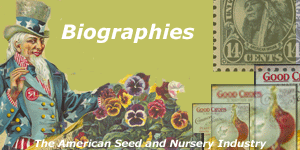
|
Pyle, Robert — (1877-1951) — West Grove, Pennsylvania — a
nurseryman and authority on roses, was born in London Grove, Pennsylvania,
the son of Robert Lewis Pyle, a successful merchant. He graduated
from Swarthmore College in 1897, and was acting superintendent of the College
until Oct. 1, 1898 when he went to work for the Conard and Jones Company
of West Grove, Pennsylvania. Conard and Jones were a mail-order nursery
and seed business that specialized in own-root roses grown from cuttings
and sold while still small. Pyle began his career by making rose
cuttings, but soon was transferred to the office. When Conard died
in 1907, Pyle and his father purchased his interest in the company and
took control of the company. Pyle became president and general manager,
and continued in those positions until he died in 1951. The business
grew rapidly after he converted the business to the sale of two-year-old
field-grown plants on grafted roots. These plants brought a higher
price and they bloomed the first year in the customer's garden. By
1910, Pyle had established Star® Roses, a nationally recognized name.
From 1919 to 1924, Pyle was president of the American Rose Society, and
from 1924 until 1933 he was executive secretary. He was also a trustee
and vice-president of All-American Rose Selections; trustee and president
of the National Association of Plant Patent Owners; a founder of the American
Association of Botanical Gardens and Arboretums, and a member of the Advisory
Council of the National Arboretum in Washington, D. C. He was the
president of the American Horticultural Society from 1932 to 1935, and
a member of the American Society for Horticultural Science. In 1910,
he wrote a pamphlet, How to Grow Roses, that was later expanded
into a book that became the largest-selling rose book of the time and went
through sixteen editions. Pyle traveled extensively looking for new
roses, but his most famous introduction was the Peace rose, patented in
1943 and introduced in 1945. It was the work of the French hybridizer
Francis Meilland. Pyle died in 1951, and in accordance with a prior
agreement his share of the business was sold to his associates, Sidney
B. Hutton, Sr., and Sidney's two sons.
Sources: Hutton; DABsup5 |